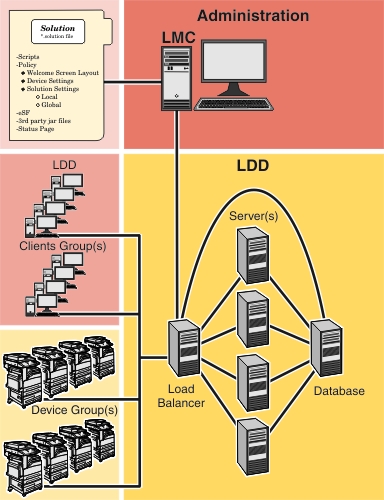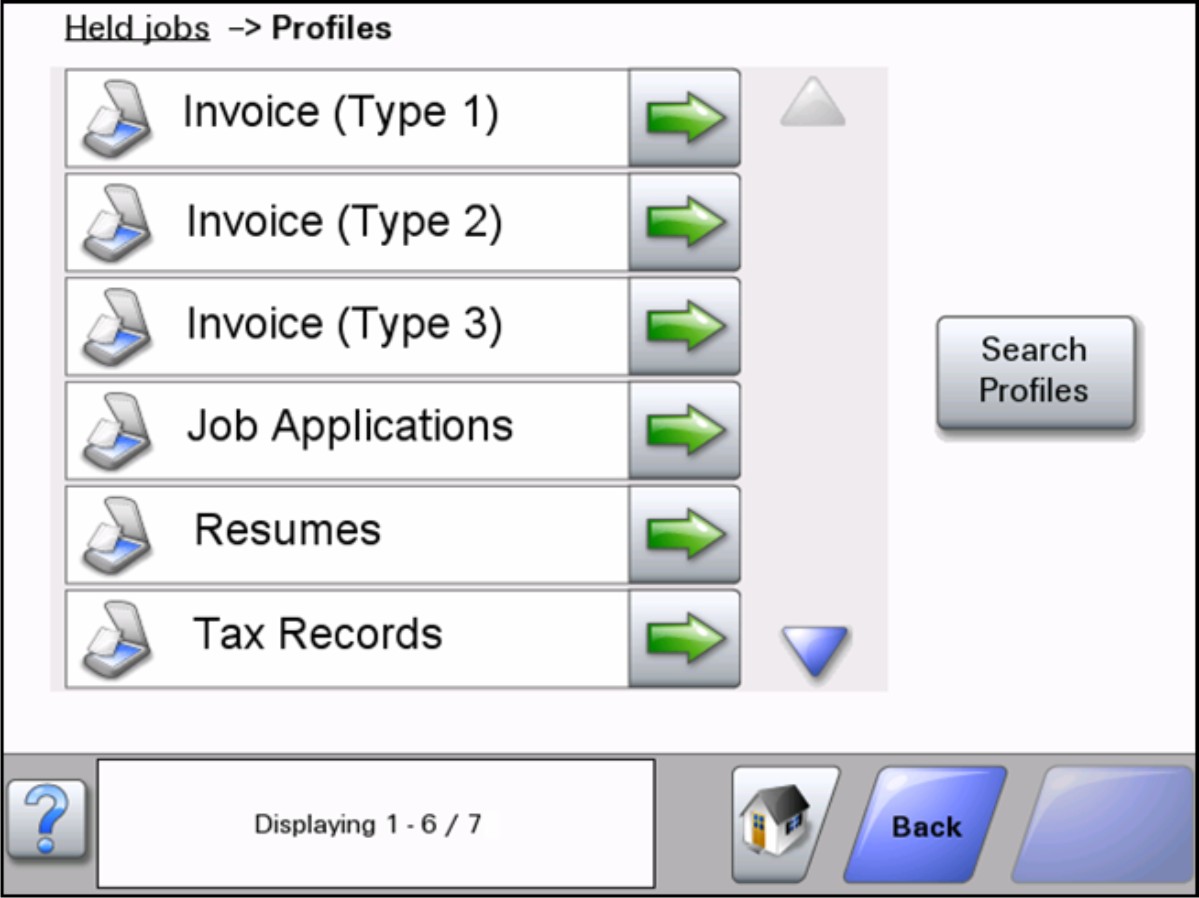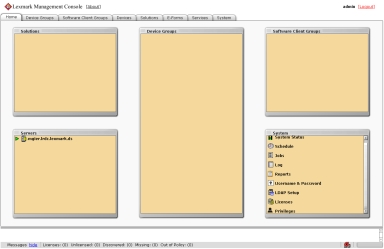Overview
LexmarkTM Document Distributor (LDD) is a system that captures paper documents and converts them to digital format. It also captures existing digital documents, and then processes and routes these documents according to your business processes. Users can submit paper documents from multifunction products (MFPs), or submit digital documents from individual computers. Some functions, such as print release, can be accessed from some single-function printers (SFPs). To view a list of supported printers, see Supported printers.
Each Lexmark MFP can print, copy, scan, e-mail, and fax. In addition to controlling and adjusting settings for these native functions, LDD can add the following functions by using scripts:
Show messages and prompt the user for input.
Authenticate through prompts or card swipes.
Combine scanned documents.
Read bar codes.
Use optical character recognition (OCR) to retrieve the text from scanned documents.
Check or validate information in documents against templates.
Automatically fill in the fields on a form template from a database or user input.
Convert documents to specific formats, such as PDF, TIFF, and plain text.
Route and store documents in a database, network location, or enterprise content management (ECM) system.
Provide a user confirmation for actions taken.
This document provides instructions on how to configure, use, and troubleshoot LDD.
Understanding the stages of a job
Document capture
The paper document is converted into a digital document from a Lexmark printer, or a digital document is selected on a user's computer. The user chooses from profiles, predefined job types that determine through scripts how the scanned document will be processed and routed. On a printer, the most commonly used profiles are often configured as buttons on the home screen.
Document processing
Document processing takes place on the LDD server after the document capture stage is complete. The document is analyzed or modified according to scripts associated with the profile selected prior to document capture.
Common tasks in document processing include reading bar codes, OCR, and image processing and manipulation.
Document routing
The main function of LDD is delivering captured documents to other systems. The LDD system uses its processing capabilities to transform paper documents into formats required by your business processes. A document can be routed to multiple destinations. When a user submits a document, LDD can automatically fax, e-mail, print, or archive it without further user intervention.
LDD can route documents to any of the following destinations:
Confirmation
After document capture, processing, and routing, the user can be provided with feedback indicating success or failure. A custom report may be printed, or for e-Task 2 or later printers, a confirmation can be shown on the screen. Other LDD services can be used for confirmation purposes. For example, an e-mail notification can be sent to the user or other recipients each time a job is completed.
Understanding the Lexmark Document Distributor system
System components
Clients—Clients can be either printers or workstations that use the Microsoft Windows® application software Select'N'Send or the Lexmark Document Server Printer Port. The document capture and confirmation stages of a job occur at a client. In printer clients, prompts may be presented to the user to collect information during document processing and document routing.
Load balancer—Receives jobs from clients and balances those jobs across servers, providing a transition between document capture and document processing stages of a job.
LDD servers—Process incoming jobs, which manage document processing and document routing stages of a job.
Database—Maintains information about clients, solutions, settings, and jobs.
Reliability, scalability, and disaster recovery
The load balancer, database, and server components may be installed together on one computer or separately on individual computers, depending on the demands placed on the system. However, a one-computer setup is subject to downtime if that computer fails, and the server load will be fairly limited. Ideally, a system should have at least two server computers, connected to separate database and load balancer computers.
LDD is scalable to support a large number of clients, submitting jobs to as many servers as required to handle the load. The load balancer selects a server for each received job to distribute the total load and maintain system performance. Using multiple servers also increases system reliability. If one server fails, then the load balancer will direct jobs to the other servers until the failed server is back online.
LDD uses a Tomcat Connector to manage load balancing in the system. The default balancing method is session, which estimates the number of sessions open by counting requests to the system that do not have a session cookie. The session count is decayed by dividing in half, once per minute by default. The server with the lowest number of estimated sessions is selected to process the request.
To further increase reliability by keeping the system online in the event of a failing load balancer or database, the load balancer and database can each be paired in a failover cluster using a Microsoft Cluster Server (MSCS).
Finally, you can back up the databases and solutions from the database and load balancer to a network share. If a recovery becomes necessary, then a new load balancer and/or database can access the recovery data using a Restore Install. Existing servers are directed to the new database and/or load balancer, or new servers are installed as necessary.
Workflow solutions
In LDD, workflow solution determines the specifics of each stage of a job to meet a business need. A workflow solution provides a new profile or job type that a user can initiate on a printer or software client to which it is deployed. Some solutions, however, may be scheduled to run at particular times.
A workflow solution contains one or more of the following elements:
Script—Defines the actions executed when a solution is initiated. Scripts can be static, or they may solicit user input for processing and routing documents. For example, a script that processes bank loans may request more user inputs, such as a branch name, account number, or Social Security number.
Policy—The settings for the solution and the printers to which it is deployed:
Device settings—The configuration required on printers to support the jobs. This configuration typically includes profiles but can include almost any device setting.
Solution settings—Settings that allow you to adjust jobs or printer configurations. Some settings are global to the solution across all printers, while others vary from one group of printers to another.
Embedded Solution Framework (eSF) application—An application installed on printers to provide functionality needed by the solution, such as delayed sending of scanned documents.
Components—JAR files that provide services not available in the base LDD installation, such as interaction with a custom ECM system.
Formsets—Custom form files used for merging data with standard forms.
Custom reports—Reports created by a solution developer that present custom data.
Client software
Client software is used to submit files from a Windows operating system computer to the LDD system for processing. A computer that uses client software is a software client. LDD can process documents submitted through client software in the same way as documents scanned at a printer.
| Note: For more information on the latest LDD port monitor support, see the Readme file. |
There are two types of client software:
Select'N'Send—Users send files directly to LDD and select LDD profiles to use in processing the sent files. Selected files are submitted to the system in their current formats. This client software is a Windows operating system application that has both a command-line utility and a graphical user interface (GUI) version.
| Note: The Microsoft Windows application software Select'N'Send does not support prompting from an LDD server system profile. |
Lexmark Document Server Printer Port—Users submit documents to LDD by printing from any Windows operating system application to a print queue assigned to the port. Printed documents are submitted to the system in the format determined by the print driver used with the print queue.
An LDD printer port can now be assigned to an LDD server system profile that prompts for user input at the time of printing. The profile or script running on the LDD server system that the LDD printer port is assigned to controls the prompting. For LDD printer port prompting, install the LDD port monitor software on the computer. Create and assign the LDD printer port to a profile that prompts to an existing print queue.
Notes:
- The LDD printer port allows printers that belong to a solution to accept multiple domain configurations. This feature allows a solution to distinguish the same user name across multiple domains. A user's domain name, legacy account name, principal name, or fully qualified distinguished name can be shown when viewing jobs from a solution.
- LDD printer port prompting is not supported on print servers. If configured on a print server, then the spooler stops responding and may crash when print jobs start going into the print server. You can still use LDD printer ports on print servers, but you can assign them only to profiles that do not prompt.
- Configure the nonprompting profiles with a property in the SDK that specifies that the profile does not prompt. It helps improve the performance of an LDD printer port assigned to a nonprompting profile. For more information, see the Lexmark Document Distributor SDK Guide.
Lexmark Management Console
Lexmark Management Console (LMC) provides system administration for LDD. LMC is a web application hosted on LDD servers and accessed through the computer where the load balancer is installed. LMC is accessible from anywhere on the network using a Flash® plug-in with a supported browser.
Security overview
Administrative security—LMC is password protected so that only authorized administrators can access it.
User authentication—Printers may require users to log in to run profiles. Text and password prompts are available for use in scripts. Kerberos authentication is available for use only with printers that support it.
| Note: Enable secure communication between printers and servers in LMC for any device group that uses a solution with Kerberos authentication. |
Data encryption—Data encryption is available for communication between any two LDD components or with any Lexmark printer that supports encryption. Encryption for communication between LDD components is accomplished using Internet Protocol Security (IPsec) through your operating system. Encryption for communication with printers can be enabled for each device group in LMC.
System setup overview
Each of the following steps represents a different stage of the system setup process, covered in the chapter indicated:
Activate the appropriate licenses, and then install the database, load balancer, and servers. For more information, see Installing Lexmark Document Distributor.
Perform initial system configuration, including setting up device groups, discovering printers, and scheduling a backup. For more information, see Managing device groups and devices and Backup and disaster recovery.
Deploy solutions to printers. For more information, see Managing solutions and cSF apps.
If you are using software clients, prepare software client groups and install client software where necessary. For more information, see Managing software clients.
Test deployed solutions on printers and software clients. For more information, see Testing and using Lexmark Document Distributor solutions.
Supported printers
MFPsSFPs | 7- or 10-inch screen MFPsCX510 MX610, MX611 MX6500e MX710, MX711 MX810, MX811, MX812 MX910, MX911, MX912
4.3-inch screen MFPs7-inch screen SFP4.3-inch screen SFPs | MFPs6500e X548 X746, X748 X792 X925 X950, X952, X954
SFPs | MFPsX463, X464, X466 X651, X652, X654, X656, X658 X734, X736, X738 X860, X862, X864
SFP | MFPsX644, X646 X772 X782 X850, X852, X854 X940, X945
SFPs | MFPsX6203 X632, X6343 X7523 X8203 X830, X8323 X9123
SFPsC520, C522, C5244 C530, C532, C5344 C734, C7364 C780, C7824 C9204 C9354 E4504 E460, E4624 T640, T642, T6444 T650, T6524 W8404
| X642 |
Notes:
- For more information on the latest device and firmware level support, see the Readme file.
- Some printer models do not support double-byte characters. For more information, see Double-byte character support.
Supported ECM software platforms
Notes:
- Integration with ECM systems may require specific licenses.
- For ECM platforms without direct integration, the LDD system saves documents and metadata to a directory where an ECM system is configured to poll for files.


